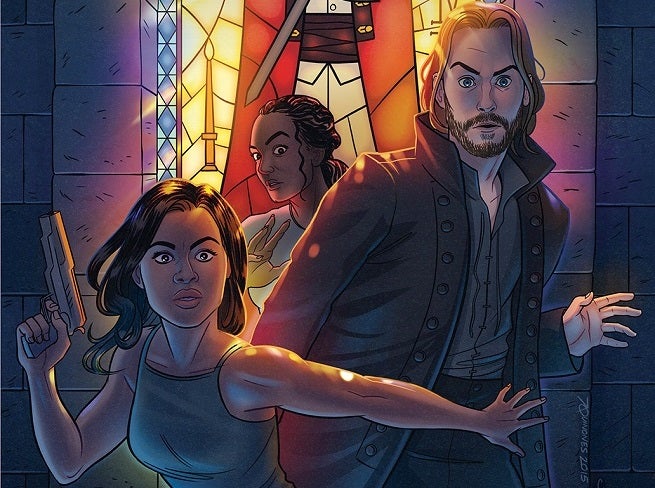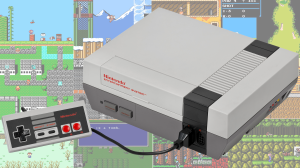This week, BOOM! Studios returned to the world of Sleepy Hollow with the first issue of their new miniseries, Sleepy Hollow: Providence.
Videos by ComicBook.com
From former Sleepy Hollow TV writer Eric Carrasco and artist Victor Santos, Jenny returns to Sleepy Hollow with an ancient artifact she’s discovered: a mysterious shard of metal with untold power. But as Ichabod and Abbie investigate, the artifact attracts a demonic biker gang called The Wild Hunt, ready to cut down anyone who stands in their way!
Carrasco joined ComicBook.com to talk about the series. Check it out below.
There are some huge changes that have been teased for the upcoming season of the TV series. Does this series tease some of that, or is it more firmly-entrenched in the threats fans are familiar with from the first two seasons?
Providence starts a month after Season 2 ends, so the threats we know are over. No more Moloch, no more Henry, and Katrina is gone. Our heroes are out of their comfort zone. We spend two issues in the town we know, see some new corners of it, and then send Abbie, Crane, and Jenny into a strange land (Amish country!) and an entirely new mythology.
Because it’s not mired in what’s come before, people should be able to jump on without having seen the show and enjoy it as a good ol’ monster-hunt. But at the end of the day, this is about the Sleepyheads. For fans, we used continuity where it informed the emotional arcs or where it would reward close reads with easter eggs.
One thing I wanted to bring to this was a real sense of the community of Sleepy Hollow—Abbie meets people from her past, Adams the antiques shop guy from Season 1 makes a return, along with Big Ash from Season 2—those are the places where I found continuity helpful.
As for the future, our job is to tee Crane, Jenny, and Abbie up for what’s ahead. At the end of this mini, the characters are on their emotional starting blocks for Season 3. We also broaden the magical world. The Witnesses were promised years of tribulations, and not all of that will be Biblically-rooted. This opens the door for international folklore, and a bigger world than Abbie and Crane could have imagined.
What can you tease about the Wild Hunt that makes them a formidable threat to people who have already kind of been there, done that and might not be too intimidated by just a gang of bikers?
Without giving everything away, they are definitely more-than-human. We know the team can beat witches and hold off Horsemen of the Apocalypse, but they haven’t come up against bad guys like this. And maybe not for the reasons you’d think.
Do they have any connection to the, ahem, classic DC Comics villain the Wild Huntsman? (I kid, I kid!)
Holy cow, I think I have this guy’s Zero Hour issue! Blast from the past. And yikes, how badly does he want to be Doomsday?
Is Jenny a character you felt left the show too soon, or was bringing her back just a convenient way to kick off this adventure?
We never wanted Jenny to be a plot point. She’s a great story engine, and there’s a temptation to have her roll in with a magical whatzit just in the nick of time, but as far as I’m concerned, every time she ducks offscreen on the show, she’s on an adventure that’s almost as compelling as Abbie and Crane’s. Jenny’s got an internal life, her own problems, her own emotional core. She is part of the Trinity.
What’s it been like working with Victor Santos? What do you think he brings to the project that nobody else could? When you’re looking at these comics, do you feel like they capture the tone and look of the show?
Those questions are tied together for me, because one of my favorite things about BOOM!’s licensed books is the stylized art. There’s a tendency in tie-ins to capture actor likenesses at all costs. On this, Victor isn’t drawing Tom Mison and Nicole Beharie, he’s drawing Ichabod and Abbie. It’s about mannerisms, movements, posture… it’s got verve to it. It doesn’t just look like Sleepy Hollow, it is Sleepy Hollow.
And he can do things the show can’t. On page one of the first issue, he gives Jenny’s hand this great-big Saul Bass-looking shadow that sells the atmosphere so hard. That’s the magic of abstraction. It’s that, and also his design work. Right from the jump, he invented a biker gang that hadn’t appeared on the show. By the time we get to Issue 3, we have an almost entirely new cast of characters, and he differentiates them so well. Even when I can’t devote too many panels to characters, they feel like real people.
As somebody who used to write for the show as well, are there things you’re doing here to take advantage of the comics medium in particular?
First, I had help: my editors, Dafna Pleban and Mary Gumport, brought a metric ton of story and emotion, and kept the focus on character, and they have a bottomless knowledge of this medium. But I wasn’t coming at it completely cold. I wanted to write comics before I even thought about screenwriting. I grew up buying every Wednesday (multiple copies of everything because it was the ’90s and foil covers are neat), and I picked up trades, too because every once in a while, you’d find one with backmatter that had a script in it. Tearing those apart and reading Will Eisner books and Denny O’Neill’s book on writing set me up well.
The big trick was figuring out how decompressed the storytelling should be. Do we make it cinematic, or go classical and have a page where four, well-chosen images span a week’s worth of events? … Once we figured that out (and decided against internal monologue), we started to play with conventions.
How detailed do we want to go here? Am I going to put people to sleep? Here’s an example. In movies, there’s “pre-lapping”—hearing sound or dialogue before cutting to the next scene. But comics can also make dialogue land harder by making the end of a line a caption over a thematically-related next image. “Post-lapping,” I guess. Little stuff like that is all over this. Victor does cool Sin City-ish silhouettes throughout, Jason Wordie colors the hell out of them with these surprising, creative palettes, and in the next issue there’s some Matt Fraction-y tricks with word bubbles that take advantage of Jim Campbell’s awesome lettering—we have some fun with atypical onomatopoeia…
And there’s obviously the “unlimited” budget thing. The show looks great. It’s huge and expensive. But in a comic I could send Jenny to Mars or have them fight Kaiju. I wanted to take advantage of that without breaking the mythology. Sometimes comics based on shows don’t feel “real” because they’re so massive, you feel like going forward, surely the characters would mention the time they all wore mech-suits to fight a giant space-octopus. Our solution was to level-up the action and spell-casting, do stuff like dogs that are difficult to manage on set, and take us to lots of new locations. None of it would be out of place in an episode of the show, but all of it together? That’s a seriously expensive episode. I had a ton of freedom and so much fun. Mostly, I feel lucky. It’s my first comic, and I have Joe Quinones covers! And Faith Erin Hicks and Rob Guillory variants!
Plus, Victor and I got do a story about Amish wizards and evil bikers. It’s so crazy it might even work.









